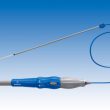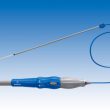The ADVANCE study was designed to evaluate the safety and effectiveness of transcatheter aortic valve replacement (TAVR) with self-expanding prosthesis CoreValve in “real world” patients with symptomatic, severe aortic stenosis at high surgical risk. Patients were enrolled from 44 experimental centers in 12 countries; treatment approach and choice of anaesthesia were determined by the local Heart Team....
Small Annulus: Should We Start Choosing the Valve?
Courtesy of Dr. Carlos Fava. A small annulus in patients with Severe Aortic Stenosis is a real challenge, since it is associated with post-surgical prosthesis patient mismatch (PPM), which negatively affects prosthesis duration and evolution. TAVR has become a good alternative strategy, with better hemodynamic profile and lower PPM incidence in this group. The present study included 246...
Positive Outcomes of CoreValve Evolut in Large Population
The Evolut R, as well as its predecessor the CoreValve, is a self-expandable valve, supra-annular, made of porcine pericardium in a nitinol frame. Amongst its improvements, it has a better profile and the option to resheath. This makes it fully repositionable and even recapturable. We only needed to confirm these technical advantages would translate into clinical...
NOTION: TAVI with low risk at 4 year follow up
Courtesy of the SBHCI. There is little data about the use of transcatheter aortic valve replacement (TAVR) to treat patients with severe aortic stenosis at low surgical risk. Many of the questions involve long term duration of valves (over 10 years) when treating younger patients with longer life expectancy. The NOTION study aims at comparing...
CENTERA: Results of the New Self-Expandable Valve
This new device offers the advantage of a lower frame height, which reduces the chance of coronary occlusion. The delivery system is totally motorized and the valve can be repositioned. In addition, the sheath is “14 F” for all valve sizes (23, 26 and 29mm). 203 patients were included, all with severe aortic stenosis...
REPRISE III: Lotus and CoreValve Compared in High-Risk or Inoperable Patients
The efficacy of transcatheter aortic valve replacement (TAVR) has been well-established. However, its limitations include suboptimal deployment and paravalvular leak. The Lotus system is a fully repositionable and retrievable device with controlled mechanical expansion. It features an adaptive seal to minimize paravalvular leak, it does not require early pacing during deployment, and, given its early...
Surgery or TAVR in intermediate risk? Results of the SURTAVI Study
Courtesy of Dr. Gustavo Leiva. Transcatheter aortic-valve replacement (TAVR) with the use of a self-expanding prosthesis is superior to medical therapy in patients with severe, symptomatic aortic stenosis in whom surgical aortic-valve replacement has been associated with prohibitive risk. Among patients considered at high risk, TAVR may be an alternative to surgery. The comparative...
Evolut R: Clinical Results Might Be Better than Those for First-Generation CoreValve
Two recent articles featured in JACC Cardiovascular Interventions showed that short term (at 30 days) outcomes of patients treated with the next-generation self-expanding Medtronic Evolut R valves could present several advantages compared to the original CoreValve, including recapturability. Both analyses reported similar rates of all-cause mortality and stroke. The study carried out by Dr. Jeffrey Popma as...
TAVR: Reasons to Consider Mitral Annular Calcification
Courtesy of Dr. Carlos Fava. Aortic valve calcification and mitral annular calcification have the same etiology and are frequently present in high-risk patients undergoing transcatheter aortic valve replacement (TAVR). The implications of mitral annular calcification for patients undergoing TAVR has not been entirely clarified yet. The study examined 782 patients with severe aortic stenosis who underwent...
See the Presentations of the 2016 Chile Sessions
We thank all the speakers of the Chile 2016 Sessions who shared their presentations to contribute to our mission of promoting the dissemination of information from research and clinical practice in Interventional Cardiology. You can read and/or download them below Lluberas, Ricardo. “Role of pharmacovasive therapy in the treatment of IAMcEST. Implications for Latin...









